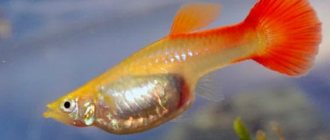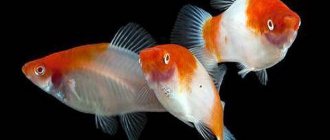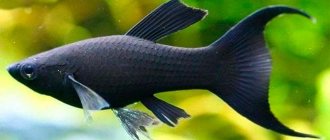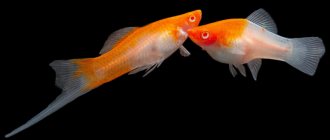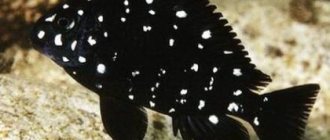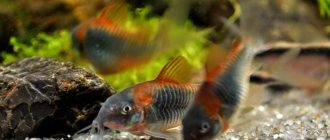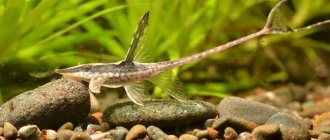Igor Shelestov: Photo report. Published 07/30/2019
The town of Utinta on the map of Lake Tanganyika. Populations of Cyprichromis leptosoma “Utinta flyorescent” are “based” 30 km north of the village of Kipili . Very similar cyprichromis, live near Msalaba (Msalaba) Tanzania
The eastern shore of Lake Tanganyika near Utinta, Msalaba, Kigoma and the southern end of the lake near Mpulungu are the most famous habitats of the “little” leptosis. In the lake, different species of Tanganyikan cichlids often gather and “cruise” in large flocks. In the picture In the picture taken by Milkunie in 2012 near Kigoma there is a flock consisting of cyprichromis, paracyprichromis, neolamprologus...
These bright small leptozomas live in the lake at depths from 5 to 30 meters
At speed male Cyprichromis leptosoma "Utinta flyorescent"
“flies up” to the female and, spreading its fins, begins in a small frantic “shaking”
Cyprichromis leptosoma is the smallest representative of the genus. In an aquarium, adult males reach only 8 cm. They reach maturity at 6 - 7 months with approximately the same size in centimeters
This male is extremely popular. Simultaneously spawns with two females. The third one is further away and another one didn’t make it into the frame...
Cyprichromis leptosoma "Utinta flyorescent" in
near the lair of long-bodied Telmatochromis
In the decorative aquarium, the back wall is lined with emerald slate, and in the foreground there are scarlet stones with white veins. One of my favorite shots
Sometimes 4 transverse stripes appear on the body of male ducks. In my opinion, their appearance only benefits from this
Cyprichromis sometimes destroy established stereotypes and swim into such shelters, beloved by some lamprologus
Playing with the pelvic fins is designed to attract females. Females always “buy” this bait. And what does it look like!?
Small cyprichromis more than compensate for the difference of a couple of centimeters with truly “formula” speeds. You have a split second and half a chance to press the button and record the “flight” of the male.
The small mouth of cyprichromis is specially designed for uninterrupted catching of zooplankton. However, these specialized “plankton eaters” are capable of accepting much larger food objects in aquarium conditions. The coretra, floating in the water column, is often especially loved
Koretra
What is extremely gratifying for the aquarist is that the dominant males of Cyprichromis allow their competitors to become fully colored
Habitat
Endemic to one of the largest lakes in Africa - Tanganyika.
The lake washes 4 states at once. The greatest extent is in Tanzania and the Democratic Republic of the Congo. Fish live everywhere throughout the lake. They prefer open areas of water. Brief information:
- Aquarium volume - from 110 liters.
- Temperature - 24–27°C
- pH value – 7.8–9.0
- Water hardness - medium to high hardness (10–25 dGH)
- Substrate type - any
- Lighting - moderate
- Brackish water - no
- Water movement - weak, moderate
- The size of the fish is up to 12 cm.
- Food - any food floating on the surface
- Temperament - peaceful
- Keeping a camp of at least 8 fish
Maintenance and care, arrangement of the aquarium
The optimal tank size for a group of 8 or more fish starts from 110 liters. They prefer to stay in the upper layers of the water, so design does not matter much. It should be selected based on the needs of other species living in the same aquarium. The presence of a lid will protect the fish from accidentally jumping out. They become especially jumpy during the mating season. The key to keeping Cyprichromis leptosoma is to ensure high quality water with appropriate hydrochemical pH and dGH values. These goals are served by a productive filtration system, regular cleaning of the aquarium from organic waste and weekly replacement of part of the water (15–20% of the volume) with fresh water.
Cyprichromis microlepidotus (Poll, 1956)
Modified: 02/18/2016 edit
Etymology (1)
The species got its name due to the fact that the scales on its side are very small. Micros - [small, small], lepidion - [scale].
Taxonomic history (2)
Limnochromis microlepidotus, Poll, 1956, original name Cyprichromis microlepidotus, Scheuermann, 1977, new name
Distribution area (3)
In suitable habitats, this species is found over a fairly large area of the Lake Tanganyika coastline, from Kavala Island on the western shore of the lake to Bulu Point in Tanzania (Ad Konings, 1998). Some sources (HJ Herrmann, 1996) note that there are facts of discovery of Cyprichromis microlepidotus further south on the coast of Tanzania in the Sibwesa region and south of Kavala along the coast of Congo, and even in Chituta Bay in Zambia. But if one can still believe in the possibility of the existence of Cyprichromis microlepidotus "Sibwesa", then populations of this species in Zambia are unlikely, since similar biotopes in the south of the lake are already occupied by Cyprichromis pavo from Kanoni on the coast of the Congo, to Cape Mpimbwe on the coast of Tanzania (Ad Konings, 1998). The holotype for description was caught in the Ubwari Peninsula area in the northwestern region of Lake Tanganyika, at a depth of 10-12 m.
Holotype: IRSNB 283.
Paratypes: IRSNB 284-285 (22, 5).
Appearance (4)
Polygynous cichlids, the eggs are raised in the mouth by females. Full length up to 11 cm. The female is slightly smaller. Sexual dichromatism is striking. Males usually have more attractive colored fins.
Especially if they have blue-black or yellow colors. Cyprichromis microlepidotus is one of many species in Lake Tanganyika that has a large number of color morphs. Since the species is generally quite sedentary (that is, does not undergo much horizontal movement), it is possible that due to separation and subsequent isolation, genetic changes occur leading to the development of geographical color forms. As a rule, such geovariants can be easily differentiated.
The body is elongated and has a spindle-shaped shape. The straight mouth can protrude far forward. The upper and lower jaws have many rows of conical teeth. Cyprichromis microlepidotus, has tiny scales along the longitudinal line of the body and because of them can be easily differentiated from other scientifically described members of the genus. All other varieties have 39-41 scales along the longitudinal line of the body, compared to the tiny 63-71 scales of Cyprichromis microlepidotus. Cyprichromis pavo can also be differentiated by its pelvic fins being pointed and slightly elongated, extending into the area of the hard rays of its anal fin.
Sex differences (5)
Sexual dimorphism is pronounced. Males usually have more attractive colored fins.
Biotope (6)
This cichlid lives at depths of 5 to 30 meters in open water close to large rocks. Usually found in relatively large schools, in which females and young males are placed in the center, and adult males swim around the edges, trying to attract the attention of females ready to spawn. Fish in a school are collected close to each other, and sometimes in shallow water in these schools Paracyprichromis brieni is found together with Cyprichromis microlepidotus.
Contents (7)
The aquarium should contain areas of open water and high areas to give a certain naturalness to the interior and delimit the territories. The bottom should be made of fine or medium river sand, not too light. Plants do not grow in natural habitats of this species, although there is no reason not to include a few plants to liven up the decoration of the aquarium. Cyprichromis spp. will not dig up or nibble plants. The bottom area of the aquarium should be at least 150 cm x 50 cm, so that these graceful open water cichlids do not feel too cramped. Cyprichromis microlepidotus should not be kept in pairs, rather groups of at least 10 to 15 fish are required for successful breeding. The number of males may account for more than a third of the group. Cyprichromis spp. get along well in aquariums with other lake cichlids. And since they mainly live in open water and do not compete with lithophilous cichlids or bottom-dwelling species. Ideal aquarium partners are bottom-dwelling Xenotilapia. Grammatotria lemairii, Lestradea perspicax, Ectodus descampsi, Cardiopharynx schoutedeni or similar Paracyprichromis spp. The main thing is to provide them with an aquarium of sufficient size. Co-keeping with the herbivores Petrochromis and Tropheus has been practiced with success by some aquarists and is sometimes recommended. Although in fact it is not correct to keep herbivorous and planktivorous fish together. If the aquarium has a small rocky area, then small Lamprologini may be neighbors. Food: brine shrimp, mosquito larvae, cyclops, daphnia and flake food.
Water parameters (8)
It is recommended to keep lake cichlids. Tanganyika in an aquarium with water at pH values between 7.5 and 8.8. It is undesirable to use driftwood and peat fibers for decorative purposes. To stabilize the pH, shell rock and marble are often used. Read more about pH in Sergei Anikshtein’s article “pH and Buffer”. Magnesium hardness predominates in lake water, so sometimes breeders practice adding magnesium sulfate to the water. For all cichlids of the lake, the following indicators can be considered acceptable: GH: 15-30, KN: 5-15. When keeping cichlids from Lake Tanganyika, the water temperature should be maintained at 24-27C. Higher T values are unacceptable (especially long-term ones). Regular aeration and filtration of water is required, as well as regular, at least once a week, replacement of 10-20% of the water in the aquarium with fresh water or organization of flow changes.
Food (9)
Cyprichromis microlepidotus continuously eats plankton. Feeding behavior can be easily observed, both in the wild and in the aquarium. The fish quickly move back and forth with their extendable mouths to collect moving small food. In nature, their food is crustaceans and phytoplankton. So feeding Cyclops and other crustaceans in captivity is naturally preferable.
Breeding (10)
Although males exhibit territorial behavior, intraspecific aggression consists mainly of displays of fury and expulsion of competitors from their territory. Fights leading to damage do not occur at all. Intraspecific aggression can be reduced by keeping large numbers of adult males together, as conflict is then shared. In a 400-450 liter aquarium, a group of 4 - 6 males and 12 - 15 females is optimal. Sexually mature males defend territory against other males of their species. If there is a female ready to spawn in the aquarium, then the male begins his courtship. The mating ritual consists of spreading and rapidly vibrating the fins and areas of the soft rays of the dorsal and anal fins. Sometimes the pelvic fins (and even the caudal fins) also participate in the dance. The yellow areas of the ventral fins attract females. At the moment when the female approaches the male's pelvic fins, he releases the seed. Before this, the female releases eggs directly into the water column and takes them into her mouth. This interesting procedure of fertilization of spawning is repeated several times. Females stand upside down in the water while laying eggs. The eggs gradually sink downwards, at which time the female slowly moves back and up. Finally, when the eggs are within reach, the female opens her capacious mouth and captures the egg. Subsequently, the eggs are fertilized directly in the mouth. The eggs can be fertilized by several different males. The female incubates the eggs for approximately 3.5 weeks. During this time, she continues to eat small food. The brood usually consists of 5-15 fry. Young fish can be fed on Artemia nauplii and small Cyclops.
Comment (11)
Cyprichromis spp. - An excellent fish for the aquarium. Because they reproduce without any problems with a minimum of maintenance effort.
Extras (12)
In addition to this description, you can try to search on our website for articles
devoted to representatives of the genus to which Cyprichromis microlepidotus (Poll, 1956) belongs. The information posted on the FishBase.org website may also be useful and interesting for you.
List of geographical morphs of the species:
- Cyprichromis microlepidotus "Kasai"
- Cyprichromis microlepidotus "Kavalla"
- Cyprichromis microlepidotus "Kiriza"
- Cyprichromis microlepidotus "Mabo"
- Cyprichromis microlepidotus "Magara"
Breeding/reproduction
Breeding Cyprichromis leptosoma does not cause big problems, but to preserve the offspring, spawning is recommended to be carried out in a species aquarium. With the onset of the mating season, males occupy certain areas in the water column and drive away competitors who encroach on their territory. Females can swim unhindered throughout the entire volume. When the female is ready, she accepts the advances of one of the males and releases several eggs (5–20 pieces) and immediately takes them into her mouth. Fertilization occurs inside the oral cavity. The male releases the seed and the female inhales it. The incubation period lasts about 4 weeks. Such gestation of eggs is characteristic of many species of Lake Tanganyika and serves as a reliable mechanism for protecting future offspring.
Cyprichromis leptosoma
Cyprichromis leptosoma, or leptozoma (Sardine Cichlid) is the smallest representative of the genus. This is a peaceful, colorful fish that is easy to keep and breed. Suitable for beginner aquarists. Endemic to Lake Tanganyika (Africa), where it lives in small flocks in open water. In nature, fish continuously feed on crustaceans and phytoplankton. Group spawning. The eggs are laid in the water column. The brood usually consists of 5-15 fry.
Cyprichromis leptosoma 'kitumba'
Habitat: Lake Tanganyika (Africa), off the southeastern coast of Tanzania. Habitat: lives in schools at a depth of 5 to 30 meters in open water close to large stones. Description: body elongated, graceful. The mouth is straight, the upper jaws have three and the lower jaws have four rows of conical teeth. The dorsal and anal fins are elongated. Colour: The body is dark gray with a bluish-violet tint and a bright yellow to orange tail. The tips of the pelvic fins are light. There are black spots on the dorsal fin. The caudal fin and base of the tail are yellow-orange. The main color background in females is gray-green, the tail is grayish. Juveniles are colored like females. There are two forms of this species: yellowtail and bluetail. Size: males - 10-11 cm, females - 8-9 cm. Life expectancy: about 8 years.
Yellowtail buck
Aquarium: a community aquarium of an oblong shape, covered with a lid on top (the bottom area is more important than the height). Dimensions: for a small flock (3-4 males and 6-8 females) - from 250 l (with a bottom area of 150x50 cm). Water: water hardness 10-20°, pH 7.5-8.8, regular aeration and filtration, weekly water changes up to 20-30% of water. Temperature: 25-26°C. Lighting: diffused.
Soil: fine river sand, not too light. Plants: Tall plants with leaves reaching the surface of the water (for example, Vallisneria, Elodea) are planted around the perimeter. Cyprichromis plants are not touched. Decoration: several large stones. Requires a lot of free space for swimming. It is not advisable to use driftwood in decoration.
Feeding: In nature they continuously feed on crustaceans and phytoplankton. In aquariums they readily take insect larvae, brine shrimp, cyclops, daphnia and plant-based flake food.
Behavior: in nature they live in large flocks. Character: peaceful, active and temperamental fish. Males defend their territory from other males of their species, although without causing much harm to each other. Water zone: upper and middle layers of water. Can be kept with: other Tanganyikan cichlids. Cannot be kept with: aggressive fish.
Cyprichromis leptosoma 'karilani'
Fish breeding: group spawning. The eggs are laid in the water column. A male can take turns spawning with several females. For spawning you need a spacious aquarium - from 250 liters. The female releases eggs into the water column and takes them into her mouth. The eggs can be fertilized by several males. Sexual differences: males are larger than females, brighter in color. Puberty: occurs at 10-12 months. Amount of caviar: up to 10-15 eggs (about 4 mm in size). Incubation period: the female incubates the eggs in her mouth for 3-4 weeks. Offspring: the brood usually consists of 5-15 fry. The fry are very large and can immediately feed on the cyclops. Starter food: Artemia nauplii, small cyclops, commercial food for fry. Feeding of juveniles: small live cyclops and Artemia nauplii. Removal from parents: parents do not touch their own fry.
Fish diseases
The main cause of most diseases of cichlids from Lake Tanganyika is unsuitable housing conditions and poor quality food, which often leads to a disease such as African bloat. If the first symptoms are detected, you should check the water parameters and the presence of high concentrations of hazardous substances (ammonia, nitrites, nitrates, etc.), if necessary, bring all indicators back to normal and only then begin treatment. Read more about symptoms and treatment methods in the section “Diseases of aquarium fish”.
Aqualife
D. Vanyushkin https://www.tanganyika.ru (published 11/21/2004 / dvan)
| Cyprichromis leptosoma “Mpulungu”, male Photo by D. Vanyushkin |
Among the numerous inhabitants of Lake Tanganyika, representatives of the genus Cyprichromis and very close to it Paracyprichromis personally evoke some special sympathy for me. The reason for this was not only that “cypras” became my first, truly interesting fish. And not only that, a colorful, restless flock of Cyprichromis can “revive” the appearance of any aquarium. You can’t list everything, that’s why the word “liking” is used, it’s difficult to explain “why”, but they like them. I’ll tell you about my own observations of one of the most beautiful morphs of the species Cyprichromis leptosoma - “Mpulungu”.
I received my first ciphers in May 2000 from Germany. The quality of the fish I received in this delivery exceeded all my expectations. The order was placed for hatchery fish and, out of habit, I expected to receive 3-4 cm of fry, like at the market. And he didn’t even bother to indicate the ratio of males and females, I thought it was too early to determine the sex. All hopes were pinned on the fact that eight individuals would produce representatives of both sexes and that spawning would be achieved. However, in the foam box I found two bags of cyprichromis... One with males and one with females. The pedantic Germans laid out 4 by 4. Of course, a much better combination would have been 2 males + 6 females, or at least 3 + 5... But the 7 cm beauties that I received instead of the “expected” fry brightened up the failure with the ratio. On the same day (or rather night, since I received the fish at 2 am) the volume prepared in advance was filled. Quite a lot of nerves were spent, a lot of worries about “whether they will survive or not,” how to plant, how to catch, how to add water... Unfortunately, one male also managed to jump out of the bag onto the floor. In general, the night went “successfully”, and a lot of mistakes were made. But all complexes regarding the difficulty of keeping “imported” fish were broken. It turned out that the expats handled the transportation relatively well and in the morning they were happily bustling around waiting for their portion of Cyclops ice cream. I think it’s time to make a small digression at this point on the topic: where, who, what...?
| Port of Mpulungu (Zambia). |
So, Cyprochromis leptosoma "Mpulungu" lives in the area where the first specimens were caught, which served as the type specimen for the description of the species C. leptosoma. Colonies of this population are found along the coast of Zambia and Tanzania from Mpulungu, in the Chituta, Isanga areas and to Kasanga in the north (Ad Konings, 1998). This variation gets its name from the most famous place in the area, Mpulungu Bay, also known as Kinyamkolo, or Niamkolo. This fairly well-explored area of the coast is known for a lot of interesting cichlid morphs (for example, the bright Tropheus moorii "Mpulungu" with an orange-yellow spot on its side). Mpulungu is Zambia's only port. The ferry pier and harbor provide both passenger transportation and the export and import of goods. The town of the same name is nearby, and its small number of shops and markets come alive with the arrival of ships carrying passengers and goods from Burundi and Tanzania. The port is located in a natural bay, protected by a large island several hundred meters in size. The inhabitants are mainly fishermen and every evening at sunset a long procession of fishing boats and large fishing barges pulls into the port.
The species Cyprichromis leptosoma itself was described by D. Boulanger back in 1898. The type specimen (BMNH 1898.9.9.40-41) was part of the collection of JES Moore, on the basis of which 28 more species of Tanganyika cichlids were described in 1898. Boulanger included in his work an extremely accurate map on which one can see an island known as Kumbula Island, then known as Niamkolo Island. This island is located directly in front of Mpulungu Bay. The map also includes Mutondwe Island, which is further north (HJ Herrmann, 1995). The species was described as Paratilapia leptosoma, Boulenger, 1898. Later it was named Limnochromis leptosoma, until in 1991 Max Poll added it to the genus Cyprichromis Scheuermann, 1977 (Marechal, C. & M. Poll, 1991) and our “leptosoma " finally did not: Cyprichromis leptosoma (Boulenger, 1898).
Let's return to the leptozomas themselves. As I already said, the “Mpulungu” morph is one of the cutest compared to other C. leptosoma variations. Like most races of this species, the population contains males of two color variants, the so-called “blue-tails” and “yellow-tails”. There is no reliable information on how such “polychromatism” is transmitted and how it arises in males, but all my males were “yellow-tailed” and during all the spawnings not a single male “of a different skin color” emerged. That’s why I will continue to talk only about “yellow-tailed” males.
So, the spawning coloration of an adult male is simply magnificent, a bright orange-yellow tail and the base of the caudal fin, black ventral fins with yellowish tips, a steel-gray body shimmering with blue metal on the back, head, gill covers and sometimes on the sides. The dorsal fin is fluorescent blue with a black pattern. Sometimes this morph is found commercially under the commercial name "Blue Flash" (that is, "Blue Flash").
The name speaks for itself; as a rule, businessmen are precise in their definitions and try to describe the characteristics of a particular fish in a short definition. For us, aquarists, the most joyful detail is that the rather weak intraspecific aggression allows us to observe several colored males in one volume, although, of course, the subdominants do not have such gloss as the “master”. As I already said, 4 males arrived in my delivery and, strangely enough, it was not the largest that took the lead. On the very first day, one of the young “Don Juans” proclaimed himself the head of a 200-liter aquarium and actively “hooked” females swimming past.
| Description of Paratilapia leptosoma sp. n. made by D. Boulanger in 1989 Paratilapia leptosoma sp. n. The teeth are small, arranged in three rows in the upper jaw and 4 rows in the lower jaw. The outer rows contain larger teeth than the inner ones. The height of the body correlates with the length as 1 to 4. The head has a straight profile and the area behind the eyes, the diameter of the eyes correlates with the length of the head as 3.5 to 3; maxilla reaches the vertical line passing along the anterior edge of the eye or a little further; 2 rows of scales on the cheeks; The operculum is covered with scales. The gill rakers are long, smooth and closely spaced, 20 on the lower part of the arch. Dorsal fin XII 14-15; the length of the spines increases towards the last one, comparable in size to the height of the head. When folded, the pelvic fins reach the anal fin. The anal fin has formula III 10-12: the third spine is the longest, smaller than the longest spine of the dorsal fin. The caudal fin is slightly forked. The base of the tail has a length to height ratio of 2 to 1. The scales are very slightly serrated at the edges, 39-40 2-3/11; lat. l. 27-31/11. brown color inside is lighter; dorsal and anal fins without or with patterns; the caudal fin has black and brown dots closer to the base. Total length: 87 mm. Two specimens from Kinyamkolo and from the Mbiti Rocks area. |
The larger, but less mobile specimen shed its ceremonial coloring, that is, it voluntarily accepted the role of a subdominant and scurried around the aquarium in search of food together with the females. There were practically no skirmishes between males, and mutual demonstrations on the topic of “whose pine cones are in the forest” did not lead to fights or injuries. I especially want to mention the lighting. It is better to use “cold”, elevating blue, metallic and blue tones. The combination PowerGLO + LifeGLO gives an excellent result (my personal opinion). MarineGLO is still too “intrusive” and the fish in it become faded blue, somewhat “lifeless”.
Females “Mpulungu” are dressed in the standard female “clothes” of cyprochromis: a metallic body, a soft orange pattern on the transparent dorsal and anal fins. Here everything is like in the east, a woman’s task is to give birth and bear fruit, beauty is not really needed to complete this task. After all, like many cichlids of the lake. Tanganyika Cyprichromis leptosoma, carries eggs in the mouth, and only females do this. The female’s task is not to attract attention to herself, but rather, on the contrary, to disperse it. And for this you need a discreet color that “dissolves” in water. In addition, Cyprichromis females usually gather in large flocks, sometimes mixed with other species and varieties of the genus or with Paracyprichromis spp. (Ad Konings, 1998). In such schools it is much easier for fish to avoid attacks from open water predators. Thousands of eyes are much more reliable than a pair.
In the aquarium, this habit of females also manifests itself; they usually move around the aquarium observing the “pack code” - they stay together. While the males try to isolate themselves and choose some iconic place, a piece of stone or another remarkable fragment of the landscape for their territory. In nature, Cyprichromis males quite successfully control a territory in the form of a sphere with a diameter of about 80 cm, but in an aquarium, territoriality is blurred by a smaller living space, and constant proximity to other males dulls natural instincts. Sometimes, of course, quarrels happen; in such situations, the males, having spread all their fins at lightning speed, collide somewhere “on the border” of the conditional territories, and just as quickly disperse in different directions.
| The male “Mpulungu” begins courtship of the female Photo D. Vanyushkin |
| Fragment of spawning C. sp. “leptosoma Jumbo Kekese” “...the male suddenly swims behind the female’s back and extends his “folding” mouth to its full length...”. Photo by D. Vanyushkin |
| Cyprichromis leptosoma “Mpulungu”, female with eggs Photo D. Vanyushkin |
| Cyprichromis leptosoma “Mpulungu”, female with fry (if you look closely in the female’s mouth you can see the eyes of a large fry) Photo by D. Vanyushkin |
Spawning of Mpulungu proceeds according to the standard pattern for most cyprichromis. The female, ready for spawning, succumbs to the persistent advances of the male and goes to the spawning zone chosen by her partner. In my case, the volume of an aquarium with cyprichromis (200 l) is comparable to the volume of a male’s private territory in nature, and therefore the procedure for attracting females is somewhat different than in a lake. The male actually believes that females are always on his territory and therefore spawning can break out at any point in the aquarium, roughly speaking, “where he caught up”... The spawning procedure of cyprichromis itself is very beautiful, it can last for several hours in a row, until an exhausted female with a mouth full of caviar does not will go into hiding.
At the first stage: courtship is expressed in an alternation of sharp overtaking and “belly dancing”, when the male blocks the female’s path, bends sideways towards her, exposing her vibrating ventral fins, folding his dorsal, caudal and anal fins, and at the same time leans slightly on side. This acts as an invitation to the female. If she is ready to spawn, then she simply follows the male to “his territory” (in an aquarium, the couple usually just moves aside), at which time the male straightens all his fins and proudly escorts the female. Next, the male suddenly swims behind the female’s back and, extending his “folding” mouth to its full length, touches the area behind the female’s head with the end of this pipe. As if slightly biting her, squeezing all his fins. The female holds herself at an angle of about 45 (sometimes more) degrees to the bottom surface. After a moment, the female throws out one or sometimes two eggs and, moving sharply back in an arc, takes them into her mouth. The male swims forward again, tucks in all the “unnecessary” fins and, vibrating the tips of the ventral fins, shows the female the place where the milk will be released, the female seems to bite the fins and the seed falls into the mouth, where the eggs are fertilized. This ritual is repeated several times, and then the female, with her mouth full of fairly large eggs, abruptly leaves the spawning territory.
Cyprichromis eggs are yellowish, 3-3.5 mm in diameter, irregular, slightly pear-shaped. Spawning in representatives of this species begins quite early, at the age of up to a year, with the length of males about 5-5.5 cm, and therefore the productivity of an even smaller female is usually low: 5-7 eggs, in adult females up to 15.
Incubation of eggs lasts about 3-3.5 weeks, after which the females release fairly large fry, 1.2-1.4 cm in size. In nature, incubating females usually gather in huge flocks and try to release the fry at the same time (Ad Konings, 1998) . This is how their concern for their offspring is manifested, since for the first few hours the fry do not swim very confidently and can become easy prey for small predators, and “in the crowd” they have a chance to get lost and eat their neighbor. In an aquarium, the female usually chooses some kind of shelter to release the fry, where she “spits out” her offspring. Artemia and small Cyclops nauplii can be considered starter food for juveniles.
In nature, Cyprichromis are planktivores, and primarily feed on small organisms living in the water column. For this purpose, the mouth of representatives of the entire tribe Cyprichromini is adapted in a simply remarkable way. It extends in the form of a pipe 4-5 mm forward and at high speed the cypras simply “rakes in” small plankton like a net. When keeping artificially, you need to try to satisfy the feeding habits of the fish and use small feed for feeding: cyclops, grown brine shrimp (including frozen ones), and sometimes coretra. For flake foods, I personally prefer to feed plant-based foods such as TetraPhill or Wardley Spirulina (sometimes supplemented with Sera FishtaMin vitamins). Spirulina, which is part of the feed, has a beneficial effect on the blue color components, and the plant base allows, for example, to keep “predominantly herbivorous” species (Tanganicodus, Eretmodus, Opthalmotilapia) together with cypras. Of course, the diet I described for cyprichromis is not a dogma, but in my opinion it is sufficient both in terms of diversity and in terms of the presence of necessary substances (together with vitamins). All of the foods listed are easy to obtain and are relatively inexpensive. I personally try to keep my fish away from beef heart, bloodworms and tubifex.
When decorating an aquarium for cyprus, I personally support the ascetic style. Namely: fine river sand with a layer of 2 cm on the bottom, a couple of tall smooth cobblestones for abstract marking of territories and that’s it (“Kenya” I think is what we need). There is no particular need for an abundance of shelters, but they will easily become a place for the accumulation of excess organic matter, and therefore I would not force the aquarium to use sandstone, which is currently popular, besides, it is too “evil” for the delicate scales of cyprus. Sometimes, when frightened (for example, when trying to catch an incubating female from an aquarium), the fish shy away and are damaged on the sharp edges of the sandstone. This, of course, will not cause any particular harm (given normal conditions in the aquarium and good immunity of the fish), but it is unpleasant.
In conclusion, I want to say that keeping cyprichromis and related paracyprichromis is not such a difficult task, and even a novice aquarist can do it. The main thing is to remember and follow the basic principles of keeping Tanganyika cichlids. Namely: stable hydrochemical regime, pH from 7.5 and above, temperature from 25-27C, average hardness GH 12-17 and most importantly, free of phosphates, nitrates and most importantly without any signs of ammonia and ammonium content (NH3/NH4 ) -water. To be honest, my first successes in keeping and breeding “tanga” began to happen only after purchasing Tetra tests for NH3/NH4, NO2 and NO3. Not because, of course, I bought them, but because, having measured, for example, nitrates, I was horrified by their concentration and understood why the fish are so faded and the females do not bear eggs. It is the high content of nitrates (which, in fact, are not as toxic as NO2 nitrites), often even with good biofiltration, that cause health problems, decreased immunity, loss of reproductive ability in fish and unstable growth, as well as high mortality in juveniles . Regular water changes and the absence of excess organic matter are the key to the health and well-being of your fish. And if all of the above is present, there will be a good appetite, bright coloring and frequent spawning. So, I strongly recommend not to take seriously the “bad” reputation of cyprus as pampered and disease-prone fish. In most cases, aquarists simply do not know what conditions to create for their fish so that they can exist normally in captivity. So read books, articles, practice, this is the only way you can achieve real satisfaction from keeping many cichlids, including those from Lake Tanganyika.
Literature: Ad Konings “Tanganyikian Cichlids In Their Natural Habitat” CichlidPress, 1998 D. Vanyushkin. www.tanganyika.ru, July 2003

